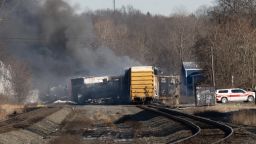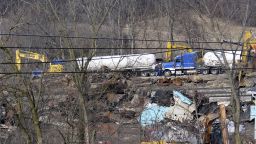The federal Environmental Protection Agency has ordered Norfolk Southern to stop its shipments of hazardous waste from the site of the train derailment in East Palestine, Ohio, so that it can review the company’s plans for disposal.
Officials in Texas and Michigan are complaining they didn’t receive any warning that contaminated water and soil from the train derailment in East Palestine, Ohio, would be shipped into their jurisdictions for disposal.
About 2 million gallons of firefighting water from the train derailment site were expected to be disposed in Harris County, Texas, with about half a million gallons already there, according to the county’s chief executive.
“It’s a very real problem, we were told yesterday the materials were coming only to learn today they’ve been here for a week,” Judge Lina Hidalgo said Thursday.
Ohio Gov. Mike DeWine was not briefed on where in the country the shipments would be sent, his spokesperson told CNN. But this is typical, as the train company is responsible for the transport of material and the EPA is responsible for regulating that transport, Daniel Tierney said.
“EPA will ensure that all waste is disposed of in a safe and lawful manner at EPA-certified facilities to prevent further release of hazardous substances and impacts to communities,” the department said in a statement to CNN on Saturday.
Three weeks after the derailment, the area surrounding the site is “definitely looking better,” EPA Director Anne Vogel said Saturday.
Federal agencies have begun transitioning from an initial emergency response phase to a remediation phase, the director said. Federal Emergency Management Agency and the Centers for Disease Control and Prevention personnel have also arrived to assist with the cleanup and to address community concerns.
Vogel said the EPA has installed “sentinel wells” near the city’s municipal well field to monitor contaminants in well water as part of the agency’s long-term early detection system “to protect the city for years to come.”
EPA Regional Administrator Debra Shore said Saturday during a press conference the agency has decades of experience dealing with hazardous waste, both in cleaning up contaminated sites and in regulating the landfills where waste is disposed.
Until Friday, Norfolk Southern “had been solely responsible for the disposal of waste generated by the East Palestine train derailment,” the department said, but waste disposal plans “will be subject to EPA review and approval moving forward.”
CNN has reached out to Norfolk Southern for comment.
Contaminated soil from the derailment site was being taken to the US Ecology Wayne Disposal in Belleville, Michigan, US Rep. Debbie Dingell of Michigan said Friday.
She told CNN’s Fredricka Whitfield on Saturday that neither she nor Michigan Gov. Gretchen Whitmer were aware of plans for toxic waste to be delivered to disposal sites in her district.
“I called everybody,” Dingell said, “Nobody had really been given a heads up that they were coming here.”
Dingell represents Michigan’s sixth congressional district which is home to two waste disposal sites.
“When I learned of this yesterday, the first call that I got, I immediately called the governor’s office, assuming that they would know about it,” she said.”What quickly became evident is that none of the elected officials, none of the local officials, knew that this material was on its way.”
In a Saturday update on the removal of contaminated waste, DeWine said 20 truckloads of hazardous solid waste has been hauled away from the derailment site. Fifteen of those truckloads were disposed of at a licensed hazardous waste treatment and disposal facility in Michigan and five truckloads were returned to East Palestine.
About 102,000 gallons of liquid waste and 4,500 cubic yards of solid waste remain in storage on site in East Palestine, not including the five truckloads returned, according to DeWine. Additional solid and liquid wastes are being generated as the cleanup progresses, he added.
The complaints widen the controversy caused by the February 3 train derailment that left residents complaining about feeling sick after hazardous chemicals seeped into the air, water and soil.
“They don’t want the worry and they don’t want the smell,” Shore said, referring to East Palestine residents. “We owe it to the people of East Palestine to move it out of the community as quickly as possible.”
A National Transportation Safety Board preliminary report found that one of the train’s cars carrying plastic pellets was heated by a hot axle that sparked the initial fire, according to Jennifer Homendy, the chair of the safety board.
Residents worry rashes and headaches may be tied to chemicals from train crash
As the temperature of the bearing got hotter, the train passed by two wayside defect detectors that did not trigger an audible alarm message because the heat threshold was not met at that point, Homendy explained. A third detector eventually picked up the high temperature, but it was already too late by then.
“This was 100% preventable. … There is no accident,” Homendy said during a news conference Thursday.
Transportation Secretary Pete Buttigieg on Saturday defended the Biden administration’s response to the disaster, saying agencies responding on the ground have been “really well coordinated.”
Buttigieg told MSNBC that the ongoing NTSB investigation into the cause of the derailment “may be a year or more before that final analysis is in.”
Texas official learned about the shipments from the news
In a news conference Thursday, Hidalgo expressed frustration that she first learned about the expected water shipments Wednesday from the news media – not from a government agency or Texas Molecular, the company hired to dispose of the water.
Hidalgo said Texas Molecular told her office Thursday that half a million gallons of the water was already in the county and the shipments began arriving around last Wednesday.
She added that although there’s no legal requirement for her office to be notified, “it doesn’t quite seem right.”
Texas Molecular is receiving the water from trucks, but it’s unclear if trucks are used for the entire trip, Hidalgo said. The company told her office they had been receiving about 30 trucks of water a day, she said.
Texas Molecular said Friday that all shipments, so far, had come by truck for the entire trip.
“Texas Molecular neither transports nor selects the mode of transportation for the water,” Jimmy Bracher, vice president of sales for VLS Environmental Solutions, which owns Texas Molecular, told CNN in a statement Friday evening.
“The company that generates the waste will determine/select who ships the wastewater and they must be DOT and EPA approved transporters,” Bracher said.
On Thursday, Texas Molecular told CNN it has been hired to dispose of potentially dangerous water from the Ohio train derailment. The company said they are experts with more than four decades of experience in managing water safely.
Hidalgo’s office has been seeking information about the disposal, including the chemical composition of the firefighting water, the precautions that were being taken, and why Harris County was the chosen site, she said.
“There’s nothing right now to tell me – to tell us – there’s going to be an accident in transport, that this is being done in such a way that is not compatible with the well, that there’s a nefarious reason why the water is coming here and not to a closer site,” Hidalgo said. “But it is our job to do basic due diligence on that information.”
More than 1.7 million gallons of contaminated liquid has been removed from the immediate site of the derailment, according to a Thursday news release from the Ohio Emergency Management Agency. Of this, more than 1.1 million gallons of “contaminated liquid” from East Palestine has so far been transported off-site, with the majority going to Texas Molecular and the rest going to a facility in Vickery, Ohio.
CNN has asked the Ohio agency the location of the remaining 581,500 gallons which has been “removed” but not “hauled off-site” and has yet to receive a response.
‘We learned about it via the grapevine,’ Dingell says
Wayne County, Michigan, officials have been in contact with officials with a variety of federal and state agencies, along with the train company involved in the derailment since learning of the transportation of the contaminated materials, Wayne County Executive Warren C. Evans said in a news conference on Friday evening. Evans said the county did not receive a call from anyone that this was happening.
“Doing it in a way that doesn’t let citizens of Wayne County know that it’s coming just looks nefarious to me,” Evans said.
Officials are not aware if this move was done “maliciously or not” but says there are “disconnects,” Evans said.
“We learned about it via the grapevine and then saw Governor DeWine announced it on his site,” Dingell said in a news conference.
Five trucks have been transported to the area so far, 99% with contaminated water and 1% with contaminated soil, according to Dingell. The truck containing soil could have been transported to the area as early mid-week, Dingell added.
Train crew not at fault, NTSB chair says
The 149-car train operated by Norfolk Southern had three employees on board: a locomotive engineer, a conductor and a trainee who were all in the head end of the locomotive, Homendy told CNN’s Jake Tapper on Thursday.
So far, the investigation found the crew did not do anything wrong prior to the derailment, though the crash was “100% preventable,” she said.
The next phase of the investigation will examine the train’s wheelset and bearing as well as the damage from the derailment, the NTSB report noted. The agency will also focus on the designs of tank cars and railcars, along with maintenance procedures and practices.
Investigators will also review the train operator’s use of wayside defect detectors and the company’s railcar inspection practices. More specifically, determining what caused the wheel bearing failure will be key to the investigation, Homendy said.
CNN’s Artemis Moshtaghian, Samantha Beech and Liam Reilly contributed to this reporting









